
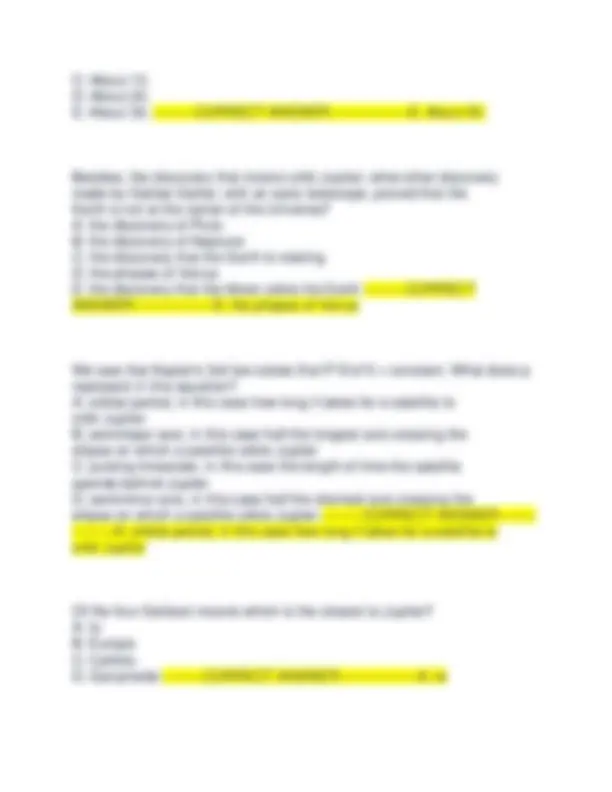
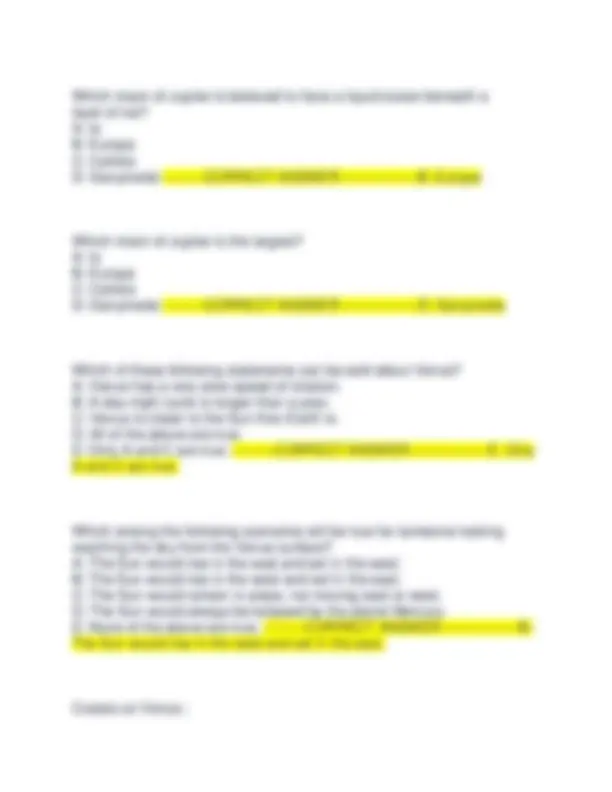

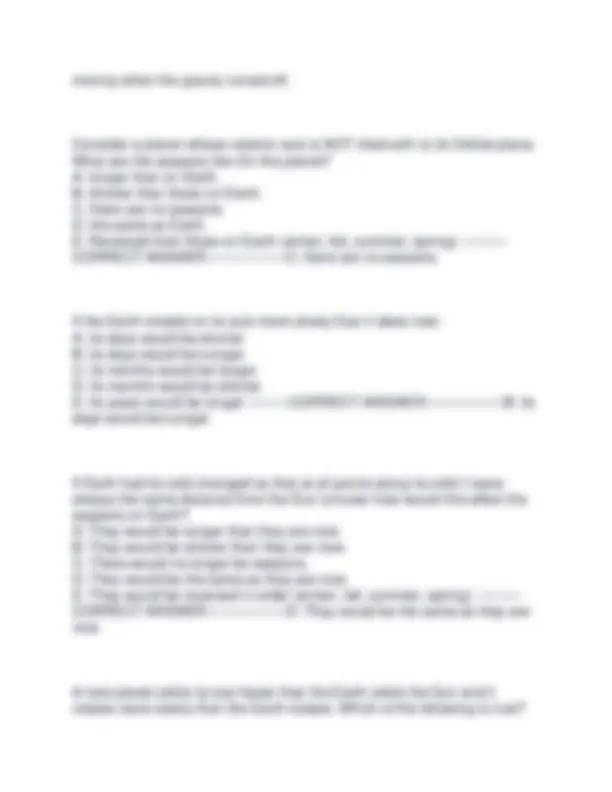
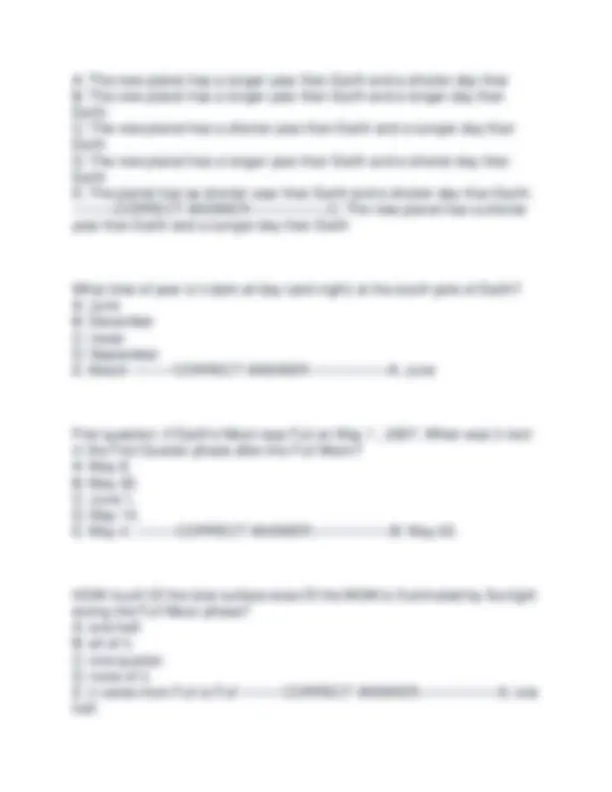
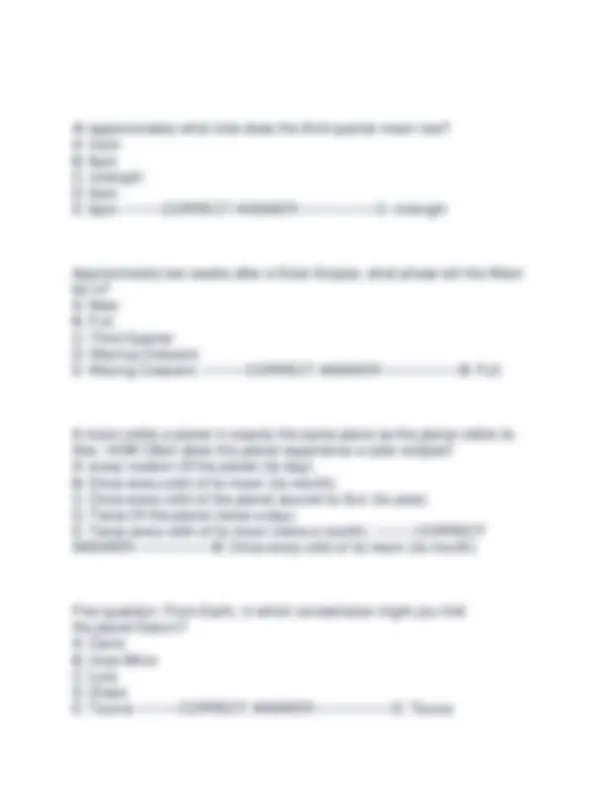

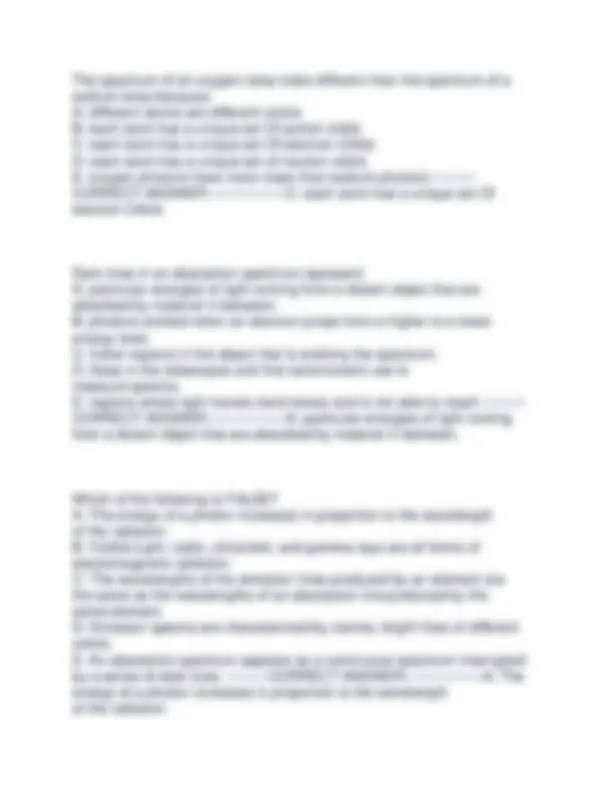
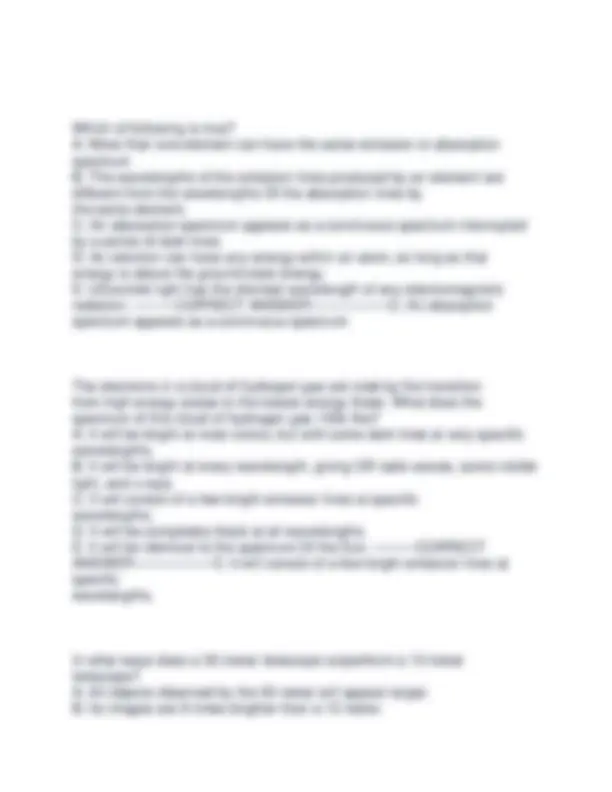
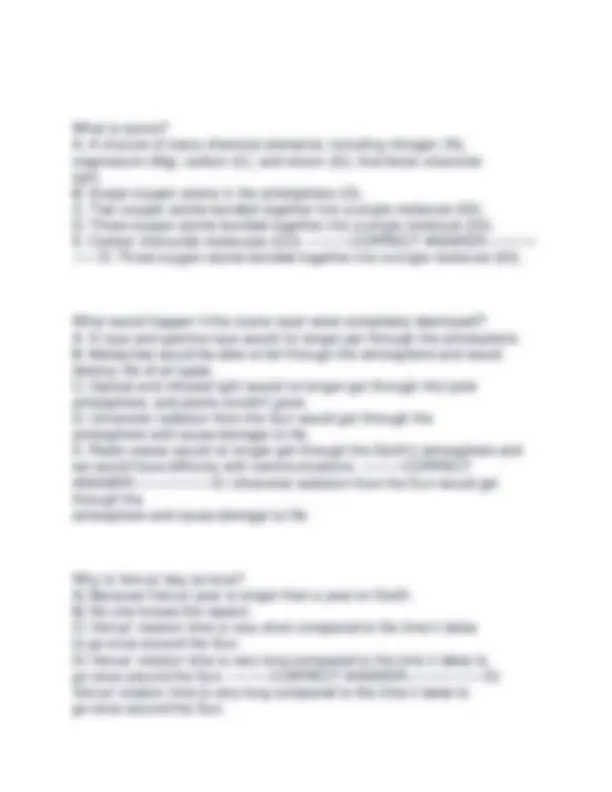
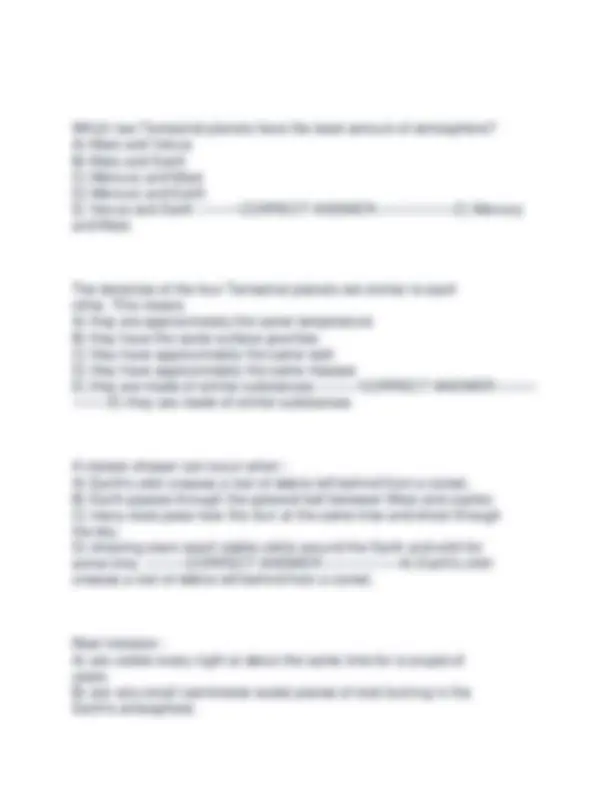
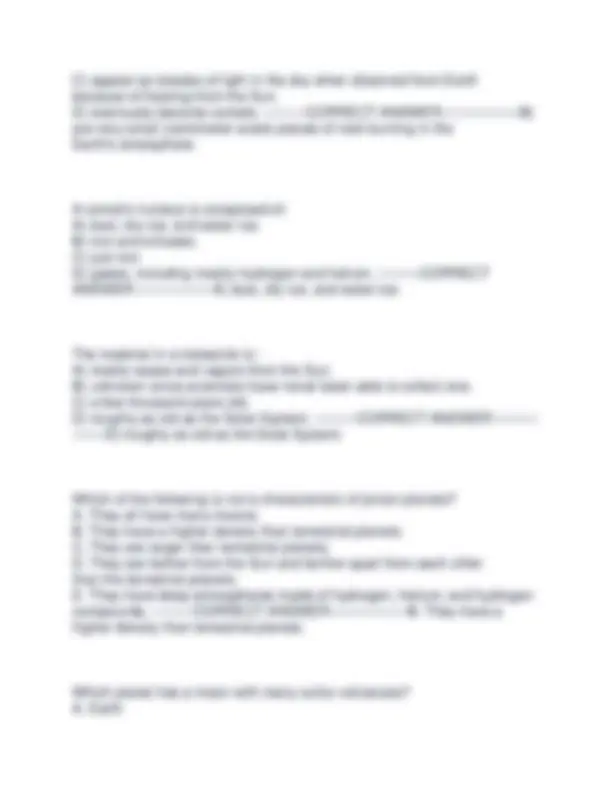
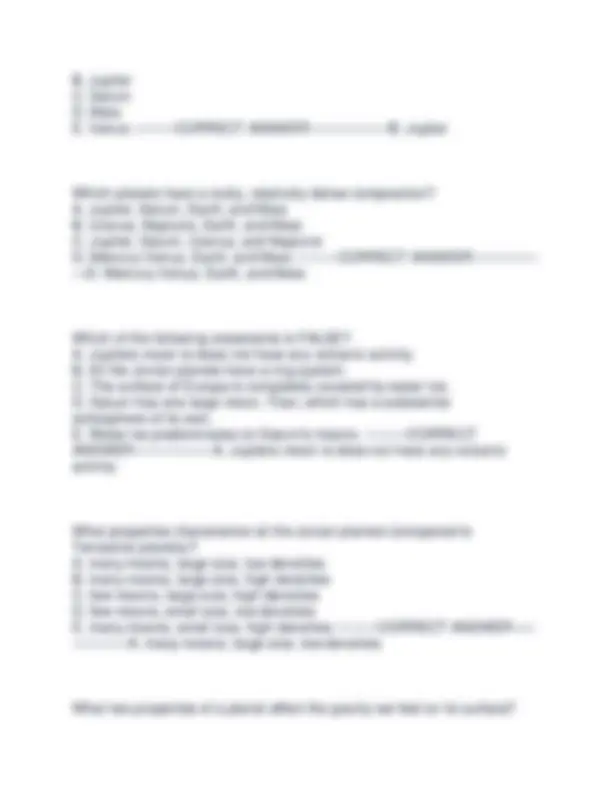
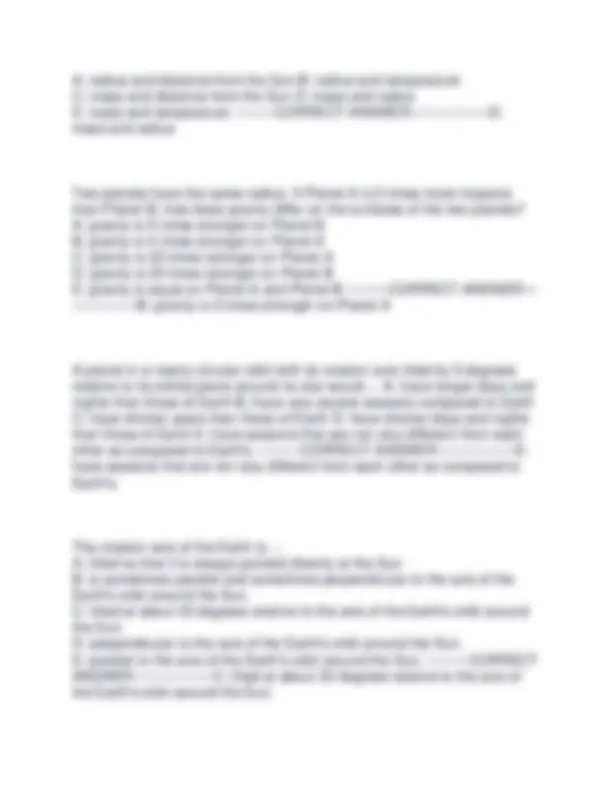
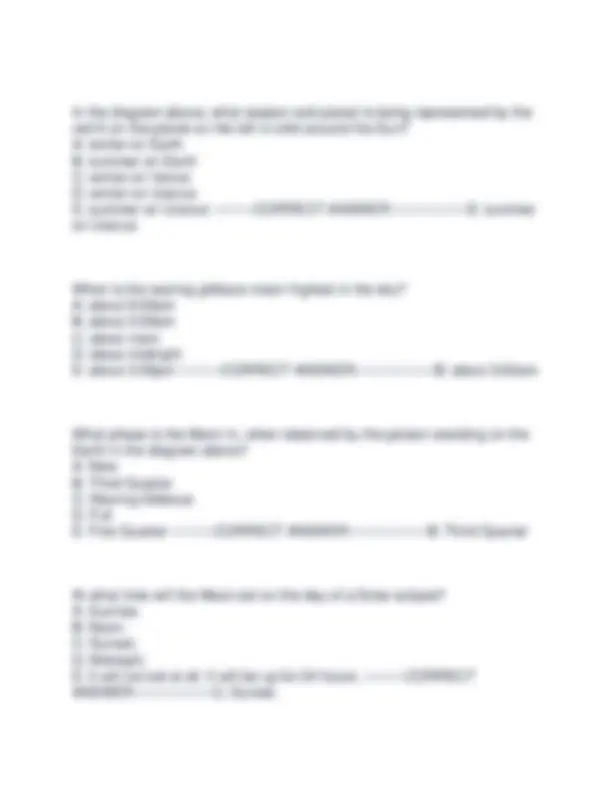
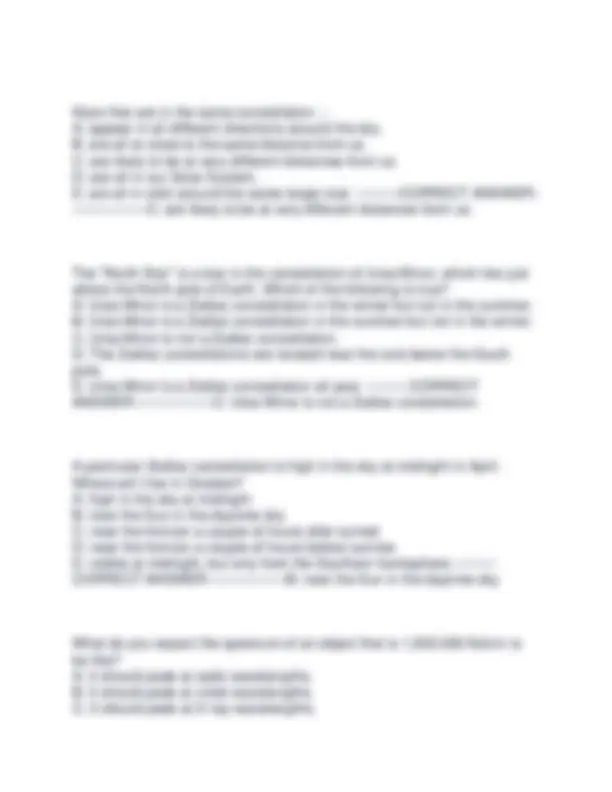
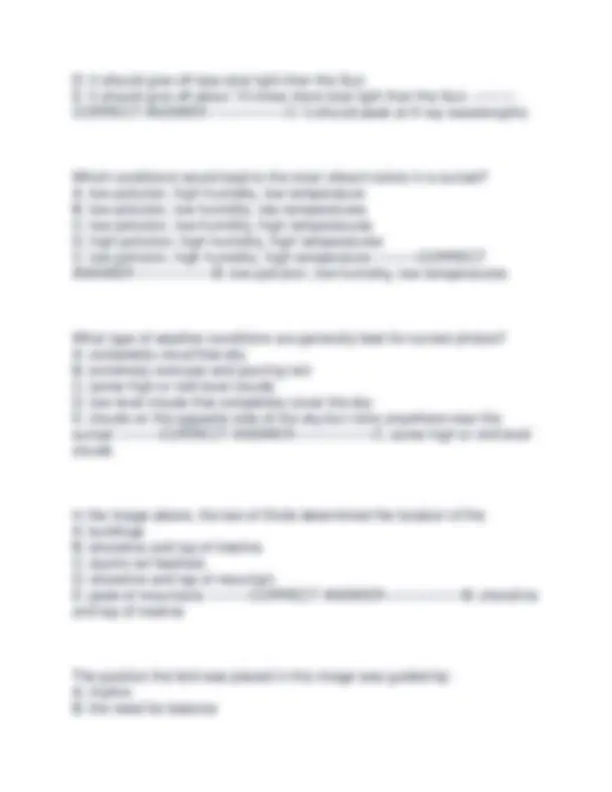
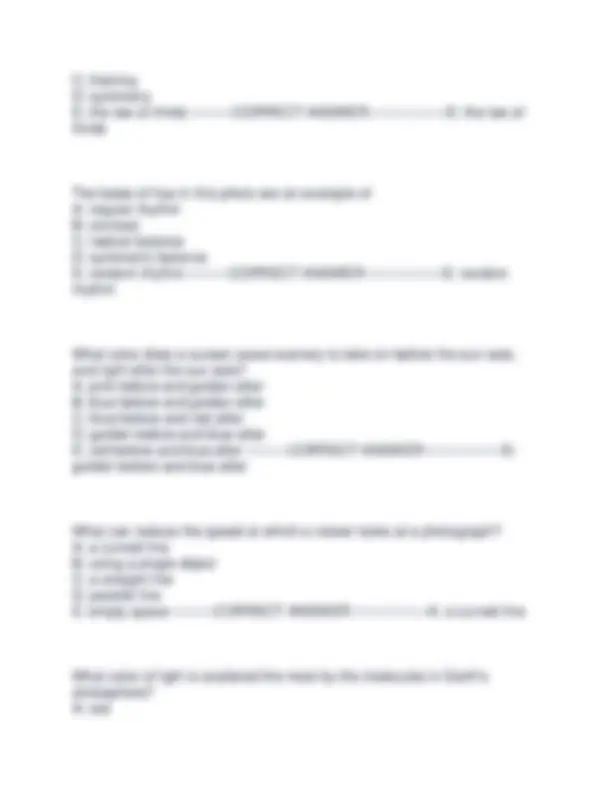
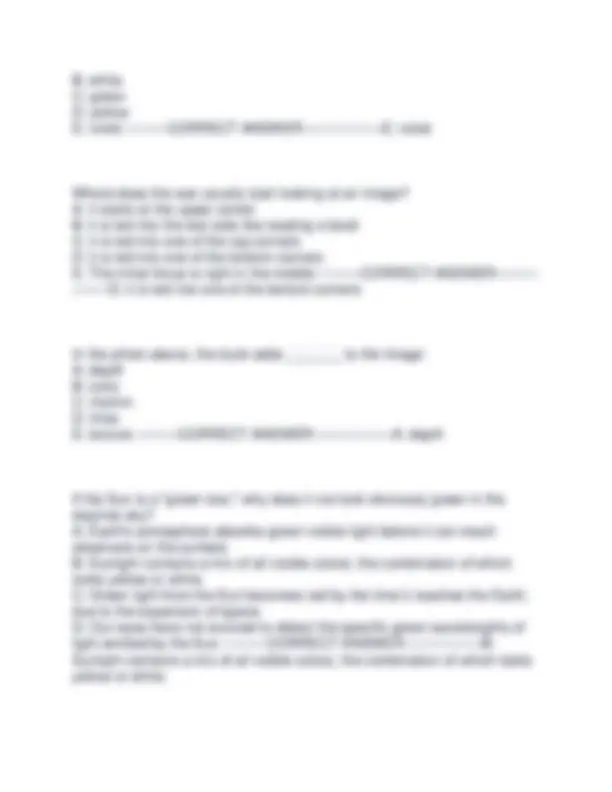
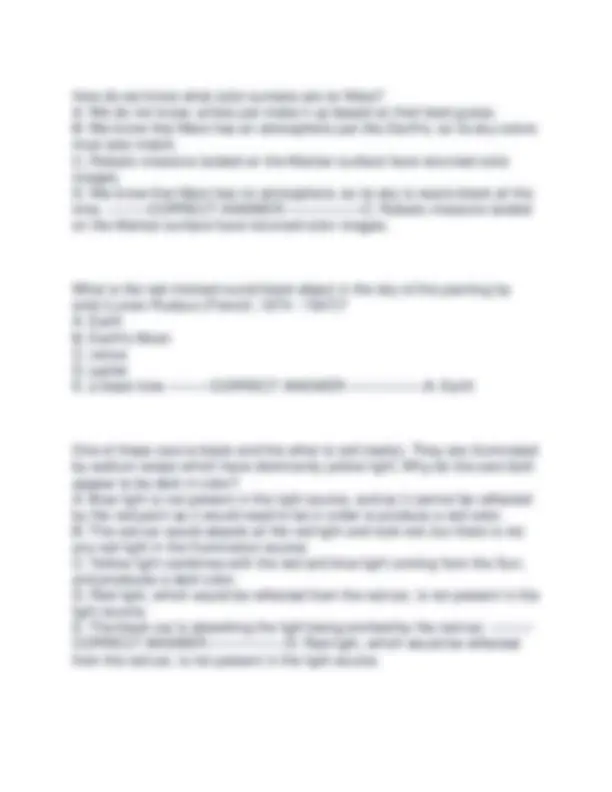
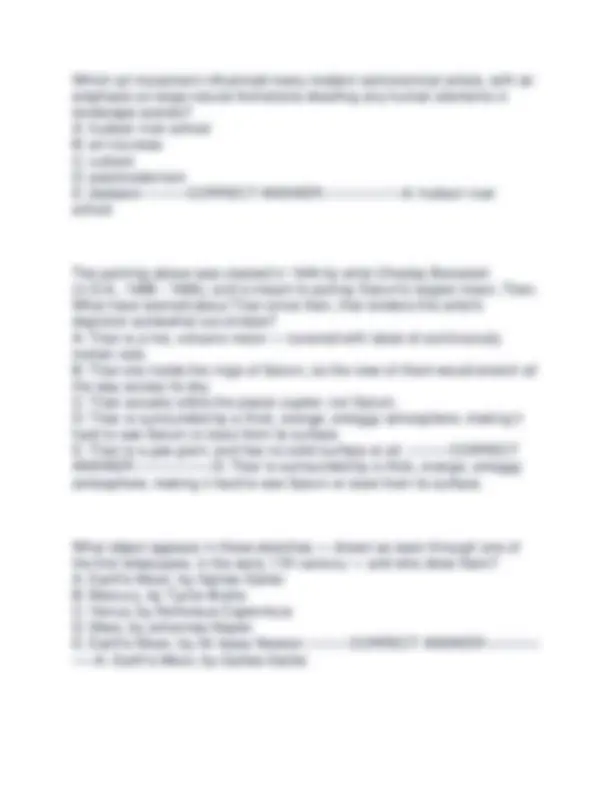
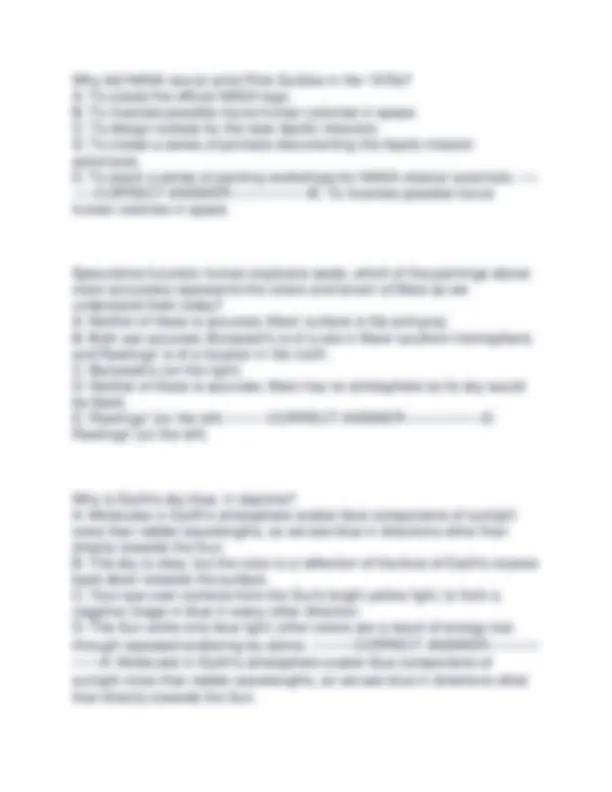


Study with the several resources on Docsity

Earn points by helping other students or get them with a premium plan


Prepare for your exams
Study with the several resources on Docsity

Earn points to download
Earn points by helping other students or get them with a premium plan
Community
Ask the community for help and clear up your study doubts
Discover the best universities in your country according to Docsity users
Free resources
Download our free guides on studying techniques, anxiety management strategies, and thesis advice from Docsity tutors
A set of multiple-choice questions and answers covering key concepts in introductory astronomy, such as kepler's laws of planetary motion, galileo's discoveries, and basic principles of gravity. It can be used as a study guide for students preparing for an introductory astronomy exam.
Typology: Exams
1 / 30

This page cannot be seen from the preview
Don't miss anything!























What was Kepler's First Law? A: Planets revolve around the sun in circular orbits with Sun in the center. B: Planets revolve around the sun in elliptical orbits with Sun at one focus of the ellipse. C: Not all planets revolve around the Sun. D: The Earth is stationary, and the Sun and other planets revolve around it. E: None Of the above. ---------CORRECT ANSWER-----------------B: Planets revolve around the sun in elliptical orbits with Sun at one focus of the ellipse. What best describes the orbit of the Earth around the Sun? A: An ellipse that is close to being circular. B: A perfect circle. C: A very elongated ellipse. D: An oscillation along a line. E: None Of the above. ---------CORRECT ANSWER-----------------A: An ellipse that is close to being circular. Which of the following does Kepler's Second Law support? A: When a planet is closer to the Sun, its speed is greater than when it is farther away. B: When a planet is closer to the Sun, its speed is less than when it is farther away. C: Planets move at constant speed in their orbit around the Sun. D: A planet's speed in its orbit is directly proportional to its distance from the Sun.
E: None of the above. ---------CORRECT ANSWER-----------------A: When a planet is closer to the Sun, its speed is greater than when it is farther away. How did Kepler himself originally state this second law? A: The speed of a planet in its orbit is directly proportional to its distance from the Sun. B: The speed of a planet in its orbit is inversely proportional to its distance from the Sun. C: All planets move at a constant speed in their orbit around the Sun. D: A line joining a planet and the Sun sweeps out equal areas in equal intervals of time. E: None of the above. ---------CORRECT ANSWER-----------------D: A line joining a planet and the Sun sweeps out equal areas in equal intervals of time. What was Kepler's Third Law? A: The farther away a planet is from the Sun, the shorter a time it takes for it to complete one orbit around the Sun. B: The cube of the time period of the planet's orbit is proportional to the square of its average distance from the Sun (P^3 is proportional to a^2). C: The square of the time period for an orbit of a planet is proportional to cube of its average distance from Sun (in other words P^2 is proportional to a^3). D: The time period for an orbit of a planet is proportional to the cube of its average distance from Sun (in other words P is proportional to a^3). E: The closer a planet is to the Sun, the longer a time it takes for it to complete orbit around the Sun. ---------CORRECT ANSWER-----------------C: The square of the time period for an orbit of a planet is proportional to cube of its average distance from Sun (in other words P^2 is proportional to a^3). Saturn is about 10 times as far from the Sun as Earth is (a = 10 AU, roughly). About how many times Earth orbit the Sun in the time it takes Saturn to orbit just once? A: About 3. B: About 5
Which moon of Jupiter is believed to have a liquid ocean beneath a layer of ice? A: Io B: Europa C: Callisto D: Ganymede ---------CORRECT ANSWER-----------------B: Europa Which moon of Jupiter is the largest? A: Io B: Europa C: Callisto D: Ganymede ---------CORRECT ANSWER-----------------D: Ganymede Which of these following statements can be said about Venus? A: Venus has a very slow speed of rotation. B: A day-night cycle is longer than a year. C: Venus is closer to the Sun than Earth is. D: All of the above are true. E: Only A and C are true. ---------CORRECT ANSWER-----------------E: Only A and C are true. Which among the following scenarios will be true for someone looking watching the sky from the Venus surface? A: The Sun would rise in the east and set in the west. B: The Sun would rise in the west and set in the east. C: The Sun would remain in place, not moving east or west. D: The Sun would always be eclipsed by the planet Mercury. E: None of the above are true. ---------CORRECT ANSWER-----------------B: The Sun would rise in the west and set in the east. Craters on Venus :
A: are about the same in size and structure to those on Earth, Moon, and Mars. B: are much larger in size than those on Earth, Moon, and Mars. C: are much smaller in size than those on Earth, Moon, and Mars. D: are never apparent because of the large amounts of volcanic activity. ---------CORRECT ANSWER-----------------B: are much larger in size than those on Earth, Moon, and Mars. Volcanos on Venus : A: produce very laree lava flows that cover at least 85% of the planet's surface. B: were never important in the planet's geological history. C: are not common, with only two apparent on its whole surface. D: are much less active than volcanos on Earth and Mars. --------- CORRECT ANSWER-----------------A: produce very laree lava flows that cover at least 85% of the planet's surface. The Greenhouse effect : A: is larger on Venus than on Earth. B: is smaller on Venus than on Earth. C: cannot exist because Venus has no atmosphere. D: is sometimes larger than on Earth and sometimes smaller. --------- CORRECT ANSWER-----------------A) is larger on Venus than on Earth. Where do mountains on Earth come from? A: Rain of debris from meteorites and comets falls in some places more than others, and builds up into mountains. B: The Earth is made of molten rock and metals, and regions with opposite electrical charges attract each other and form peaks. C: The Earth formed by an irregular processes and that is just the way that it was shaped when the molten rock cooled into place. D: In some locations, plates of rock on the planet's surface press together and the plates rise together.
E: Gravity will cause the Moon to crash into the Earth ---------CORRECT ANSWER-----------------D: The force Of gravity from the Sun Will be stronger an Object With more mass. The Earth radius is about 6400 km. If you were in orbit in the Space Station 150 km above the ground , the force Of gravity you feel from Earth would be: A: slightly weaker than when you are standing on Earth B: slightly stronger than when you are standing on Earth C: equal to What you feel when standing on Earth D: equal to What you feel when standing on the moon E: zero ---------CORRECT ANSWER-----------------A: slightly weaker than when you are standing on Earth If you were to sit on the ground, there would be a force to gravity pulling you toward the Earth. Which of the following is true to Newton's 3rd law? A: you are pulling the Earth toward yourself with the same force B: you are not exerting any force on the Earth C: you are pushing the Earth away With Same D: you will continue to sit in the same place without moving --------- CORRECT ANSWER-----------------A: you are pulling the Earth toward yourself with the same force What would to the Earth if the Sun's gravity somehow turned Off instantaneously? A: It Would continue to orbit Without any changes. It gradually Slow down and to a complete Stop. C: It would gradually speed up but continue to follow the same path. D: It would come to a stop. E: It would continue to move in a line in the same direction it Was moving when the gravity turned off. ---------CORRECT ANSWER-------------- ---E: It would continue to move in a line in the same direction it Was
moving when the gravity turned off. Consider a planet whose rotation axis is NOT tilted with to its Orbital plane. What are the seasons like On this planet? A: longer than on Earth. B: shorter than those on Earth. C: there are no seasons. D: the same as Earth. E: Reversed from those on Earth (winter, fall, summer, spring). --------- CORRECT ANSWER-----------------C: there are no seasons. If the Earth rotated on its axis more slowly than it does now: A: its days would be shorter B: its days would be Longer C: its months would be longer D: its months would be shorter E: its years would be longer ---------CORRECT ANSWER-----------------B: its days would be Longer If Earth had its orbit changed so that at all points along its orbit it were always the same distance from the Sun (circular how would this affect the seasons on Earth? A: They would be longer than they are now. B: They would be shorter than they are now. C: There would no longer be seasons. D: They would be the same as they are now. E: They would be reversed in order (winter, fall, summer, spring). --------- CORRECT ANSWER-----------------D: They would be the same as they are now. A new planet orbits its star faster than the Earth orbits the Sun and it rotates more slowly than the Earth rotates. Which of the following is true?
At approximately what time does the third quarter moon rise? A: noon B: 6pm C: midnight D: 6am E: 9pm ---------CORRECT ANSWER-----------------C: midnight Approximately two weeks after a Solar Eclipse, what phase will the Moon be in? A: New. B: Full. C: Third Quarter D: Waning Crescent. E: Waxing Crescent. ---------CORRECT ANSWER-----------------B: Full. A moon orbits a planet in exactly the same plane as the planet orbits its Star. HOW Often does this planet experience a solar eclipse? A: every rotation Of the planet (its day). B: Once every orbit of its moon (its month). C: Once every orbit of the planet around its Sun (its year). D: Twice Of the planet (twice a day). E: Twice every orbit of its moon (twice a month). ---------CORRECT ANSWER-----------------B: Once every orbit of its moon (its month). First question: From Earth, in which constellation might you find the planet Saturn? A: Canis B: Ursa Minor C: Lyra D: Draco E: Taurus ---------CORRECT ANSWER-----------------E: Taurus
Why don't we see the constellation Orion at night all throughout the year? A: It is frequently eclipsed by the Moon. B: Half the year it is visible in North America, and the other half in South America. C: When we are close to Orion it appears bright, but when we are far away it gets too faint to see. D: As the Earth orbits the Sun, its nighttime side points to different constellations at different points along its orbit. E: It is not along the Ecliptic path and only the constellations of the Zodiac are visible all year round. ---------CORRECT ANSWER-----------------D: As the Earth orbits the Sun, its nighttime side points to different constellations at different points along its orbit. When is the best time for you to be able to see the constellation that is your sign of the Zodiac? A: At noon on your birthday. B: At midnight on your birthday. C: At sunset on your birthday. D: At sunset six months after your birthday. E: At midnight six months after your birthday. ---------CORRECT ANSWER- ----------------E: At midnight six months after your birthday. Constellations close to the North pole of Earth_____. (choose the best response to complete the statement) A: move in a circle around the North star, Polaris, over the course of a single night B: move in a circle around the North star, Polaris, over the course of a year C: are only visible from the Southern hemisphere in the Summer D: are only visible from the Southern hemisphere in the Winter
B: gamma ray frequency and wavelength is the same as visible light C: gamma ray frequency is higher and its wavelength is higher D: gamma ray frequency is higher and its wavelength is lower E: Gamma ray frequency is lower and its wavelength is lower --------- CORRECT ANSWER-----------------D: gamma ray frequency is higher and its wavelength is lower If the frequency Of radiation is twice as large then its wavelength is A: half as large B: twice as large C: one quarter as larger D: four times as laree E: one hundred times as large ---------CORRECT ANSWER-----------------A: half as large Compared to blue light, red light has A: shorter wavelength , larger frequency, greater energy B: longer wavelength, Larger frequency, larger energy C: shorter wavelength, smaller frequency, larger energy D: shorter, wavelength, Larger frequency, smaller energy E: longer wavelength, smaller frequency, smaller energy ---------CORRECT ANSWER-----------------E: longer wavelength, smaller frequency, smaller energy Which types of radiation have lowest energy? A: X-rays and gamma rays B: infrared radiation and radio C: ultraviolet radiation and infrared radiation D: optical radiation and infrared radiation E: ultraviolet radiation and X-rays ---------CORRECT ANSWER----------------- B: infrared radiation and radio
The spectrum of an oxygen lamp looks different than the spectrum of a sodium lamp because: A: different atoms are different colors B: each atom has a unique set Of proton orbits C: each atom has a unique set Of electron Orbits D: each atom has a unique set of neutron orbits E: oxygen photons have more mass than sodium photons --------- CORRECT ANSWER-----------------C: each atom has a unique set Of electron Orbits Dark lines in an absorption spectrum represent: A: particular energies of light coming from a distant object that are absorbed by material in between. B: photons emitted when an electron jumps from a higher to a lower energy level. C: hotter regions in the object that is emitting the spectrum. D: flaws in the telescopes and that astronomers use to measure spectra. E: regions where light travels more slowly and is not able to reach --------- CORRECT ANSWER-----------------A: particular energies of light coming from a distant object that are absorbed by material in between. Which of the following is FALSE? A: The energy of a photon increases in proportion to the wavelength of the radiation. B: Visible Light, radio, ultraviolet, and gamma rays are all forms of electromagnetic radiation. C: The wavelengths of the emission lines produced by an element are the same as the wavelengths of an absorption line produced by the same element. D: Emission spectra are characterized by narrow, bright lines of different colors. E: An absorption spectrum appears as a continuous spectrum interrupted by a series of dark lines. ---------CORRECT ANSWER-----------------A: The energy of a photon increases in proportion to the wavelength of the radiation.
C: It will produce better "seeing" than the 10 meter. D: It can observe light with a wavelength 3 times longer than the 10 meter E: It will not suffer from spherical aberration like the 10 meter. --------- CORRECT ANSWER-----------------B: Its images are 9 times brighter than a 10 meter. Even the largest ground-based telescopes have resolution restrictions imposed by: A: the size of the biggest lens we can design B: chromatic aberration of incoming Star light C: atmospheric blurring of images D: imperfections in their design E: NASA headquarters ---------CORRECT ANSWER-----------------C: atmospheric blurring of images When you magnify an Object With a telescope, what else happens to your view of the sky? A: Your field Of view get larger, so you can see a larger area Of the sky B: Your field Of view gets smaller, so you can only see a small area of sky C: All the objects in the field view will appear closer to each other. D: Your field of view gets distorted, which is similar to the effect of a fish eye lens. E: The objects change color and appear redder. ---------CORRECT ANSWER-----------------B: Your field Of view gets smaller, so you can only see a small area of sky How long would need to observe a star on a 10 meter telescope to collect the same amount Of light as one collects in one hour on a 5 meter telescope? A: 15 minutes B: 1 hour C: 30 minutes D: 2.5 hours E: 4 minutes ---------CORRECT ANSWER-----------------A: 15 minutes
If a telescope in space is only 1/4 the diameter of a telescope on Earth, which of the following is true? A: The larger telescope can observe Objects for longer time periods than the space telescope. B: The larger telescope can observe objects fainter than the space telescope. C: The larger telescope collects less light than the space telescope. D: The space telescope has more light gathering power than larger telescope on the ground. E: The space telescope has a higher magnification than the larger telescope on the ground. ---------CORRECT ANSWER-----------------B: The larger telescope can observe objects fainter than the space telescope. From what was described, where are aurorae likely to be seen most frequently? A: Equally likely anywhere on Earth. B: At locations along the equator. C: At locations near the poles. D: They can only be seen from Earth orbit, not on the surface --------- CORRECT ANSWER-----------------C: At locations near the poles. What is NOT true about Earth's atmosphere? A. It contains 78% nitrogen B. It shields us from harmful ultra-violet radiatiop coming from the Sum C. It protects us from meteors (chunks of rock falling to Earth, known as shooting stars) since they burn up in the atmosphere before reaching Earth. D. It has more Carbon Dioxide than Venus, so is heated more than Venus by the Greenhouse effect. ---------CORRECT ANSWER----------------- D. It has more Carbon Dioxide than Venus, so is heated more than Venus by the Greenhouse effect.
Which two Terrestrial planets have the least amount of atmosphere? A) Mars and Venus B) Mars and Earth C) Mercury and Mars D) Mercury and Earth E) Venus and Earth ---------CORRECT ANSWER-----------------C) Mercury and Mars The densities of the four Terrestrial planets are similar to each other. This means A) they are approximately the same temperature B) they have the same surface gravities C) they have approximately the same radii D) they have approximately the same masses E) they are made of similar substances ---------CORRECT ANSWER--------- --------E) they are made of similar substances A meteor shower can occur when : A) Earth's orbit crosses a trail of debris left behind from a comet. B) Earth passes through the asteroid belt between Mars and Jupiter. C) many stars pass near the Sun at the same time and shoot through the sky. D) shooting stars reach stable orbits around the Earth and orbit for some time. ---------CORRECT ANSWER-----------------A) Earth's orbit crosses a trail of debris left behind from a comet. Most meteors : A) are visible every night at about the same time for a couple of years. B) are very small (centimeter scale) pieces of rock burning in the Earth's atmosphere.
C) appear as streaks of light in the sky when observed from Earth because of heating from the Sun. D) eventually become comets. ---------CORRECT ANSWER-----------------B) are very small (centimeter scale) pieces of rock burning in the Earth's atmosphere. A comet's nucleus is composed of: A) dust, dry ice, and water ice. B) iron and silicates. C) just iron D) gases, including mostly hydrogen and helium. ---------CORRECT ANSWER-----------------A) dust, dry ice, and water ice. The material in a meteorite is : A) mostly eases and vapors from the Sun. B) unknown since scientists have never been able to collect one. C) a few thousand years old. D) roughly as old as the Solar System. ---------CORRECT ANSWER---------- -------D) roughly as old as the Solar System. Which of the following is not a characteristic of jovian planets? A. They all have many moons. B. They have a higher density than terrestrial planets. C. They are larger than terrestrial planets. D. They are farther from the Sun and farther apart from each other than the terrestrial planets. E. They have deep atmospheres made of hydrogen, helium, and hydrogen compounds. ---------CORRECT ANSWER-----------------B. They have a higher density than terrestrial planets. Which planet has a moon with many sulfur volcanoes? A. Earth